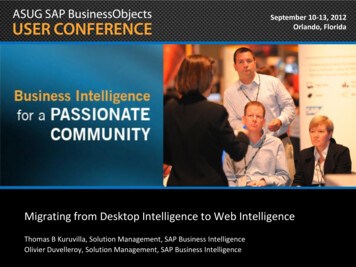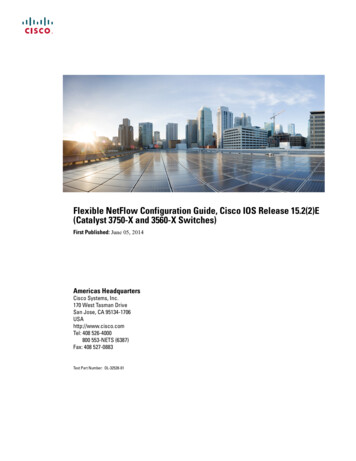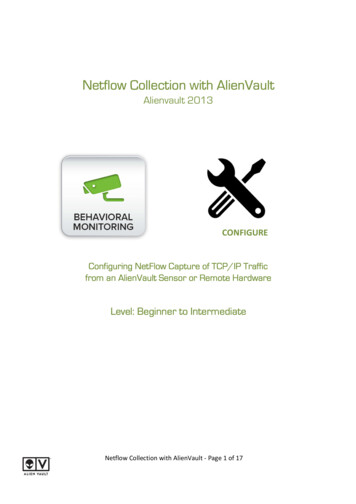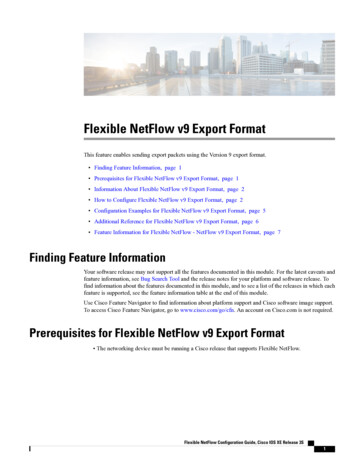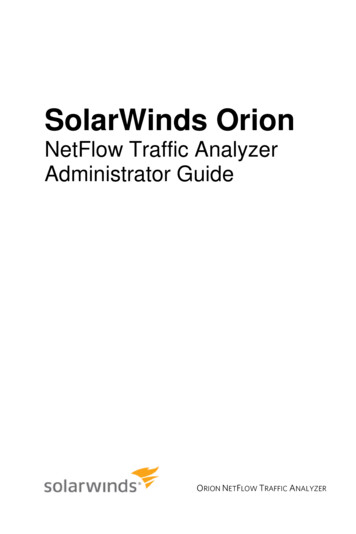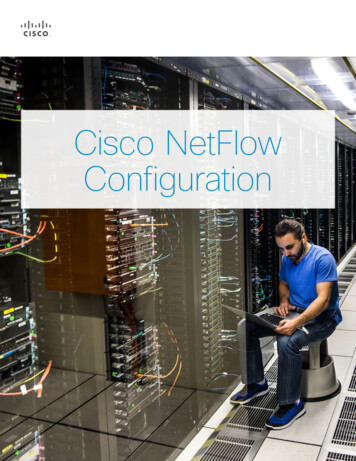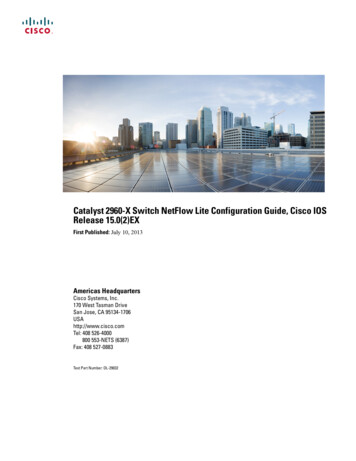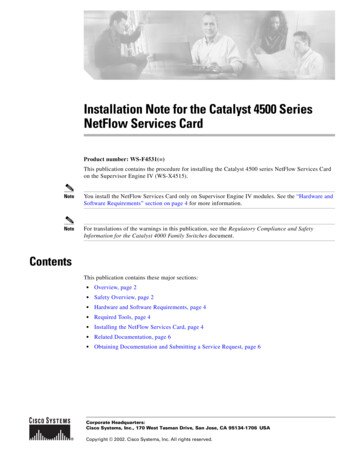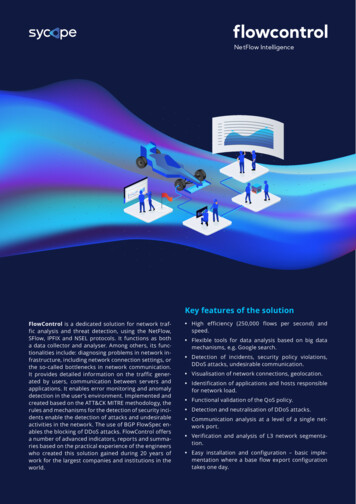
Transcription
NetFlow IntelligenceKey features of the solutionFlowControl is a dedicated solution for network traffic analysis and threat detection, using the NetFlow,SFlow, IPFIX and NSEL protocols. It functions as botha data collector and analyser. Among others, its functionalities include: diagnosing problems in network infrastructure, including network connection settings, orthe so-called bottlenecks in network communication.It provides detailed information on the traffic generated by users, communication between servers andapplications. It enables error monitoring and anomalydetection in the user’s environment. Implemented andcreated based on the ATT&CK MITRE methodology, therules and mechanisms for the detection of security incidents enable the detection of attacks and undesirableactivities in the network. The use of BGP FlowSpec enables the blocking of DDoS attacks. FlowControl offersa number of advanced indicators, reports and summaries based on the practical experience of the engineerswho created this solution gained during 20 years ofwork for the largest companies and institutions in theworld. High efficiency (250,000 flows per second) andspeed. Flexible tools for data analysis based on big datamechanisms, e.g. Google search. Detection of incidents, security policy violations,DDoS attacks, undesirable communication. Visualisation of network connections, geolocation. Identification of applications and hosts responsiblefor network load. Functional validation of the QoS policy. Detection and neutralisation of DDoS attacks. Communication analysis at a level of a single network port. Verification and analysis of L3 network segmentation. Easy installation and configuration – basic implementation where a base flow export configurationtakes one day.
Comprehensive network traffic analysisFlowControl is built of three fully integrated modules – XN, XNS and XND. The XN module is the primary module,acting as a collector, and at the same time enabling monitoring and analysis of network traffic. The XNS modulecontains numerous rules and algorithms that analyse IT security incidents. The XND module is responsible for thedetection and blocking of DDoS attacks. FlowControl records, processes and analyses all the parameters containedin NetFlow and related protocols, enhanced by SNMP data, geolocation and editable blacklists and whitelists of IPaddresses. The system analyses, among others, TCP/IP parameters in layers 3 and 4 (source and target IP address,protocol, port), traffic attributes, as well as interface numbers by traffic direction (incoming/outgoing), including theIP addresses of NetFlow generating network devices. To monitor every network of any complexity and architecture,a single virtual appliance is sufficient, which lowers investment costs and reduces implementation time.1. Implementation of the FlowControl system in a network on the example of a two-branch company.FlowControl XN — networkmonitoringFlowControl XN gathers and analyses data recordedwith NetFlow, SFlow, IPFIX and NSEL protocols for network performance and capacity.Fast access to critical informationThe system was provided with interactive diagrams,tables and maps containing critical data, statistics andindicators, enabling the analysis of network behaviourpatterns and supporting the detection of anomaliesand causes thereof. It offers the following functions,among others: Detailed statistics of the most active hosts, applications and interfaces. Information on network traffic broken down intoincoming and outgoing streams.2. A simple and clear graph shows the stations generating the most trafficas well as applications that support it and interfaces with the highestutilization. Lists of connections, including protocols, ports, IPaddresses and traffic profile for respective connections. Data on bandwidth and interface load generated byapplications, services and users. Information on incoming and outgoing traffic, including geolocation of public IP addresses.
NetFlow-generating and related devices locatedin maps and plans. Statistics enabling the assessment of properconfiguration and implementation of the QoSpolicy in place. Automatic refreshing of daily, weekly or monthlyhistorical data analysis results.Easy access to public sources The system enables access to public sources,such as VirusTotal, directly from the view underanalysis (using right mouse button) and furtheranalysis of data.NetFlow deduplicationIf the flows duplicate from multiple sources,FlowControl deduplicates data in order to retain aunique information record only. Apart from its other benefits, the deduplication mechanism allowsthe following: Presentation of actual traffic volume values, regardless of the filters applied. Displaying the traffic path based on NetFlowfields received for the same transmission frommultiple routers.Cisco ASA firewall monitoringBy supporting Cisco ASA/NSEL devices, the systemenables full access to traffic network at firewalls,which are often the only Layer 3 devices at a specific location, and, thanks to that:3. The distribution of traffic by key applications with the details of eachof them facilitates the identification of network problems related toa specific application.NetFlow analysis including autonomous systems(AS)FlowControl is designed to meet the needs of largeorganisations operating multiple connections. Supporting autonomous system (AS) technology for BGPenables the following: Viewing and filtering data based on AS numbers. Visualising traffic paths based on source/transit AS. Presentation of the sources, targets and traffic distribution across connections or operators. Enables to data analysis for firewalls only.Grouping NetFlow statistics Eliminates inconsistencies in a situation whereNSEL statistics are combined with typicalNetFlow data sent by other devices. Presentation and network segmentation analysisfor user-defined groups broken down by location,function or business role. Supports NSEL fields that go beyond a NetFlowrecord. Groups may be analysed both for outgoing and incoming traffic.FlowControl — a prompt answer to key question What applications are used? Are they all legal? Who uses the applications? What servers are the source of the traffic?Are these actually servers? Which servers are reached by the traffic?Should they be reached? Is the own and transit traffic being properlyrouted? Is a sufficient bit rate ensured bythe connections? Is the traffic being properly directed? What applications run on the servers? What applications generate the highest traffic? What ports are used by the servers? Who occupies all the available bandwidth? Where does the traffic come from and where Is the operator’s incoming traffic properly marked? Which interfaces/routers show the highest load?does it go? What servers generate the traffic? Is it legal?
FlowControl XNS – IT securityThe XNS module is an extension of the FlowControlXN system, used to detect and analyse security anomalies and threats in the context of the entire organisation. It uses rules and algorithms built on the basisof ATT&CK MITRE methodology and two independentthreat detection engines – Threat Intelligence andThreat Detection. The Threat Intelligence engine generates alerts based on correlation with reputation listsof IP addresses and suspicious countries. The ThreatDetection engine detects threats based on correlationand aggregation of connections between the valuesof various parameters and statistics of NetFlow andsimilar protocols.4. Top 10 IP addresses generating the most suspicious activity.Detection of attacks, tactics and techniquesThe use of the ATT&CK MITRE methodology enablesboth detection of incidents and analysis of event sequences and tactics used by cybercriminals. The XNSmodule contains 65 proprietary rules which detect,among others: Attacks that intend to circumvent security features. Credential-based attacks, e.g. “brute force” type attacks and LLMNR/NetBIOS communication-basedattacks. Forbidden network activities, including port scanning, attempting to gain unauthorised access tospecified services, and also anomalies in networktraffic. Remote access-based attacks, e.g. through RDP.5. Key indicators on a weekly basis allow the analysis of safety trends. Activities which indicate C&C attacks, including,among others:¶ Activities on suspicious ports (based on blacklists and whitelists).¶ Non-encrypted connections to critical serversand services.¶ Connections with suspicious IP addresses, e.g.Botnet, Malware, C2, Ransomware.¶ Security policy breaches consisting of the use ofTOR, Open DNS or Open Proxy, prohibited P2Pactivities.¶ Potential data leaks.Security Operating CenterThe XNS module was equipped with diagrams, indicators and tables adapted to the specifics of SOC teamoperations, based on NetFlow protocol analysis: Rapid detection of threats at the organisation level,taking into account various alert categories. Analysis of dynamics of changes of numbers andtype of suspicious events in a minute-by-minuteframe. Conducting analysis by the type of attack, suspected source and target hosts, and applications.6. Clear and transparent dashbord presents changes in the number ofattacks by tactics and by minute. Detailed analysis of the source and cause of a givensecurity alert through detailed NetFlow statistics,available with a single click.
Risk analysisKey indicators referring to the risk level are presented in weekly summaries and enable the tracking of trends and assessment of effectiveness ofundertaken preventive actions. Separate, dedicated dashboards present: Information about the number of attacks,divided by techniques and tactics used bycybercriminals. Risk assessment indicators generated take intoaccount the severity of alerts and hosts to whichthe anomalies and threats apply. Key Performance Indicators prepared for managers, enabling the conducting of managementanalyses. Data which enable the assessment of the degreeto which the regulatory requirements, standards and rules (such as UoKSC, CIS) are met.7. The automatically generated maps clearly show the locations fromwhich the attacks were carried out.Minimisation of the number of false positivealertsThe XNS module was equipped with multiplemechanisms, which enable the configuration ofalerts, adapting them to the specifics and needs ofthe organisation and adopted security policy. Theyinclude, among others: A configurator which enables the rapid activation and deactivation of individual security rulesand of alerts which they activate. A legible editor with a graphical interface, whichenables the rapid and convenient change of parameters used in the rules. Editable whitelists containing a set of trustedIP addresses, which may be used directly in therules. Ready-made interfaces which enable the connection of external feed databases and additional verification of risks related to a detectedincident.8. Quick access to information about the most common threats,detected by the Threat Intelligence engine.Access to the knowledge database directlyfrom the applicationThe interpretation of detected events is aided byboth a built-in knowledge database and by links tospecialised websites available with a right mousebutton click. An accessible description of a security alertsupplemented with additional information anda link to a full description of the tactic or technique in question on the ATT&CK MITRE websitefacilitate the analysis of the given event in a wider context. Suspected IP addresses may be verified in external sites (e.g. VirusTotal) directly from the XNSmodule.9. Description of tactics and techniques used in the attackfacilitates the assessment of attackers’ intentions.
Ready-made analytical scenariosThe scenarios implemented in the module facilitateanalysing and drawing conclusions concerning themost important security-related aspects. A hazard analysis scenario enables the identification of the most suspicious IP addresses, and thenthe analysis of correlations with other IP addressesor other network artifacts.10. Risk analysis based on many different graphs. Scenarios used for the analysis of internal or external attacks enable multi-dimensional analysis ofthe suspected IP address (or group of addresses):¶ Presentation of tactics and techniques usedduring attacks and generated alerts.¶ Analysis of the direction of attacks and participating hosts, taking into account source and destination addresses.Integration with other systemsThe XNS module is integrated with the XN&XND modules and enables the exporting of data to SIEM classsystems. Transferring filters defined in the XNS module tothe XN module facilitates a detailed analysis of theincident or source of the alert. The possibility of exporting alerts with their callparameters to SIEM systems, including, among others, QRadar, ArcSight and Splunk.FlowControl XND – anty DDoSThe XND module uses data from the NetFlow protocolto detect DDoS attacks on specific services performedby a monitored group of hosts, enabling use of BGPFlowSpec to block the attacks.Attack mitigation11. Basic information about DDoS attacks grouped in one place.The module enables the identification and mitigation of both single and multi-vector DDoS attacks ofvarying intensity. Based on the FlowSpec protocol, itpropagates traffic filters to edge devices. The moduledetects: Volumetric attacks, which reduce the availabilityof the service by saturating a network connection. Protocol attacks, which use a specific property orvulnerability of a given protocol.Flexible attack detection rulesThe XND module monitors changes of flow characteristics using static and dynamic parameters. Static parameters enable the definition of values usedin the process of attack identification, e.g. the number of source IP addresses, bytes, flows. Dynamic parameters enable establishing the allowable deviations from the baseline, created by comparing the current and historical traffic characteristics.12. Analysis of individual DDoS parameter values exceeded, The possibility of adapting limit values of parametersto individual groups of devices and applications facil-
itates the scaling of the system, both for the entireorganisation and taking into account specific servicesor subnets.Advanced DDoS analysisThe module has predefined dashboards for multi-dimensional attack analysis, presenting, among others: Attack start time and attack end time in the contextof the attacked service and group, to which the attacked host belongs. Type of attacked service, e.g. HTTP(s), FTP and DNS. Characteristics of DDoS parameters during the attack, e.g. the number of source ASNs, IP addresses,network flows, packets, bytes, and also PPF (Packets per Flow), BPP (Bytes per Packet).13. Graphical analysis of DDoS parametersFlowControlHigh efficiency Views are generated without the need for constantdata reloading. Negligible load on the network and network devices. Scalable mass storage enables to flexibly managedata retention periods.Alert system Alerts are generated on meeting pre-defined conditions, e.g. after exceeding the set limit for using aparticular port or application traffic volume. An alarm message is sent by email, Syslog or anSNMP trap.Flexible data analysis mechanisms Presentation of data relating to the entire network,groups of parameters or individual parameters (port,interface, host, IP) in any time window.14. Easy to carry out analyzes from general to detail thanks to drill downfunction. Easy top-down access – with just a single click, the drilldown mechanisms enable viewing of data for a specificport, interface or IP number. Searching for data in the system using analysis tools likeGoogle search. Maintaining the time context and filters between views. The possibility of saving complex search filters and timecontext (bookmarks). The XND module uses data from the NetFlow protocolto detect DDoS attacks on specific services performedby a monitored group of hosts. The system analysesDDoS parameters within the defined time frames andenables to block a service via FlowSpec.Versatile system administration tools Separate accounts for the system administrator andusers allows to determine their respective permissionswith greater precision. Possibility of authentication through the LDAP protocolor Radius service.15. Convenient system for defining and managing alarms.
Sycope is focused on designing and developing highlyspecialised IT solutions for monitoring and improvingnetwork and application performance as well as IT security both in on-premise architecture and in hybrid,private and public cloud environments.Our solutions were created and developed by engineers, who have been working on the issues of networkperformance, application efficiency and IT security forover 18 years. Using the solutions from global APM/NPM and SIEM providers, they have completed morethan 400 projects for such customers as the FranklinTempleton Investment, The Ministry of Defense, NATO,National Bank of Poland, T-Mobile, Ikea, ING Group,Orange and Alior Bank. In addition to many successful implementations, the team’s competence has beenconfirmed by many individual certificates, including:personal security clearance up to “Confidential” and“NATO Secret” clauses, CISA, CISSP, ISO 27001 LeadAuditor, IBM Certified Deployment Professional Security QRadar SIEM, ArcSight Certificate AS Data PlatformTechnical, Certified Ethical Hacker, Offensive SecurityCertified Professional.This made them convinced that engineers who work inlarge organisations do not need a system that presentsall available data about networks, devices and applications. What they need instead is selected, specific information presented as rapidly as possible. That is whythe new system called Sycope has been created.Poland Office:Goraszewska 1902-910 WarsawPolandIreland Office:Alexandra HouseThe SweepstakesBallsbridgeDublinD04 C7H2contact@sycope.comwww.sycope.com
By supporting Cisco ASA/NSEL devices, the system enables full access to traffic network at firewalls, which are often the only Layer 3 devices at a spe-cific location, and, thanks to that: Enables to data analysis for firewalls only. Eliminates inconsistencies in a situation where NSEL statisti

